Comparison of the MUSLE Model and Two Years of Solid Transport Measurement, in the Bouregreg Basin, and Impact on the Sedimentation in the Sidi Mohamed Ben Abdellah Reservoir, Morocco
Abstract
:1. Introduction
- analyzing the biophysical environment;
- describing and evaluating the erosive processes affecting the Bouregreg Basin, and the solid transport by the main tributaries to the SMBA dam;
- and identifying the priority areas contributing to siltation, in order to better guide spatial planning actions.
2. Materials and Methods
2.1. Study Area
2.2. Basic Data
2.2.1. Discharges Measurements
2.2.2. Concentration of Suspended Solids (CSS)
2.2.3. Bathymetric Data
2.3. Methods
2.3.1. Model Selection
2.3.2. Methods Selection
3. Results
3.1. Rainfall and Hydrometric Analysis
3.2. Analysis of the Biophysical Environment
3.2.1. Soil Erodibility Factor (K)
3.2.2. Topographic Factor (LS)
3.2.3. Land Cover Factor (C)
3.2.4. Average Cultivation Practices and Amenities Factor P
3.3. Application and Calibration of the MUSLE Model
3.3.1. Application of the MUSLE Model
3.3.2. Calibration of the MUSLE Model
3.4. Comparison of Observations with MUSLE Model Results
3.4.1. Aguibat Zear Hydrological Station on the Bouregreg River
3.4.2. Ras Fathia Hydrological Station on the Grou River
3.4.3. Sidi Mohamed Cherif Hydrological Station on the Machraa River
3.4.4. Ain Loudah Hydrological Station on the Korifla River
3.5. Comparison of Observations and Results of the MUSLE Model at the Four Hydrological Stations Upstream from the SMBA Dam, with Bathymetric Data
4. Discussion and Conclusions
Author Contributions
Funding
Acknowledgments
Conflicts of Interest
References
- Mahe, G.; Emran, A.; Brou, Y.T.; Tra Bi, A.Z. Analyse statistique de l’évolution de la couverture végétale à partir d’images MODIS et NOAA sur le bassin versant du Bouregreg (Maroc). Géo Obs. 2012, 20, 33–44. [Google Scholar]
- Laouina, A.; Aderghal, M.; Al Karkouri, J.; Antari, M.; Chaker, M.; Laghazi, Y.; Machmachi, I.; Machouri, N.; Nafaa, R.; Naïmi, K. The efforts for cork oak forest management and their effects on soil conservation. For. Syst. 2010, 19, 263–277. [Google Scholar] [CrossRef] [Green Version]
- Schmidt, S.; Alewell, C.; Meusburger, K. Monthly RUSLE soil erosion risk of Swiss grasslands. J. Maps 2019, 15, 247–256. [Google Scholar] [CrossRef]
- Yahiaoui, S.; Zerouali, A. Etude de l’évolution de l’occupation du sol sur deux grands bassins d’Algérie et du Maroc, et relation avec la sédimentation dans les barrages. In Considering Hydrological Change in Reservoir Planning and Management; IAHS Publ 362; Schumann, A., Belyaev, V.B., Gargouri, E., Kucera, G., Mahe, G., Eds.; IAHS Press: Wallingford, UK, 2013; pp. 115–124. [Google Scholar]
- Khomsi, K.; Mahe, G.; Sinan, M.; Snoussi, M. Hydro-climatic variability in two Moroccan watersheds: A comparative analysis of temperature, rain and flow regimes. In Climate and Land Surface Changes in Hydrology; IAHS Publ. 359; Boegh, E., Blyth, E., Hannah, D.M., Hisdal, H., Kunstmann, H., Su, B., Yilmaz, K.K., Eds.; IAHS Press: Wallingford, UK, 2013; pp. 183–190. [Google Scholar]
- Khomsi, K.; Mahe, G.; Tramblay, Y.; Sinan, M.; Snoussi, M. Regional impacts of global change: Seasonal trends in extreme rainfall, runoff and temperature in two contrasted regions of Morocco. Nat. Hazards Earth Syst. Sci. 2016, 16, 1079–1090. [Google Scholar] [CrossRef] [Green Version]
- Mahe, G.; Emran, A.; Brou, Y.T.; Tra Bi, A.Z. Impact de la variabilité climatique sur l’état de surface du bassin versant du Bouregreg (Maroc). Eur. J. Sci. Res. 2012, 84, 417–425. [Google Scholar]
- ABV. Plan National d’Aménagement des Bassins Versant; Haut-Commissariat aux Eaux et Forêts et à la Lutte Contre la Désertification: Rabat, Morocco, 1996. [Google Scholar]
- Wischmeier, W.H.; Smith, D.D. Predicting Rainfall-Erosion Losses from Cropland East of the Rocky Mountains: Guide for Selection of Practices for Soil and Water Conservation; US Department of Agriculture: Washington, DC, USA, 1965.
- Williams, J.R. Sediment-Yield Prediction with Universal Equation Using Runoff Energy Factor; ARS-S. Southern Region, Agricultural Research Service, US Department of Agriculture: Washington, DC, USA, 1975; Volume 40, p. 244.
- El Bahi, S.; El Wartiti, M.; Yassin, M.; Calle, A.; Casanova, J.L. Applying revised universal loss equation model to forest lands in Central Plateau of Morocco. Rev. Teledetección 2005, 23, 89–97. [Google Scholar]
- Chadli, K. Estimation of soil loss using RUSLE model for Sebou watershed (Morocco). Model. Earth Syst. Environ. 2016, 2, 51. [Google Scholar] [CrossRef] [Green Version]
- Elaloui, A.; Marrakchi, C.; Fekri, A.; Maimouni, S.; Aradi, M. USLE-based assessment of soil erosion by water in the watershed upstream Tessaoute (Central High Atlas, Morocco). Modeling Earth Syst. Environ. 2017, 3, 873–885. [Google Scholar] [CrossRef]
- Hara, F.; Achab, M.; Emran, A.; Mahe, G.; Fhel, B.E. Estimate the Risk of Soil Erosion Using USLE through the Development of an Open Source Desktop Application: DUSLE (Desktop Universal Soil Loss Equation). In Proceedings of the 3rd International Conference on African Large River Basin Hydrology, Alger, Algeria, May 2018; Available online: https://hal.archives-ouvertes.fr/hal-02397686/ (accessed on 17 June 2020).
- Boufala, M.; El Hmaidf, A.; Chadli, K.; Essahlaoui, A.; El Ouali, A.; Lahjouj, A. Assessment of the Risk of Soil Erosion Using RUSLE Method and SWAT Model at the M’dez Watershed, Middle Atlas, Morocco. In Proceedings of the E3S Web Conf., The Seventh International Congress “Water, Waste and Environment” (EDE7-2019), Salé, Morocco, 20–22 November 2019; Volume 150. [Google Scholar] [CrossRef]
- Toumi, S.; Meddi, M.; Mahe, G.; Brou, Y.T. Cartographie de l’érosion dans le bassin versant de l’Oued Mina en Algérie par télédétection et SIG. Hydrol. Sci. J. 2013, 58, 1–17. [Google Scholar] [CrossRef] [Green Version]
- Mihi, A.; Benarfa, N.; Arar, A. Assessing and mapping water erosion-prone areas in northeastern Algeria using analytic hierarchy process, USLE/RUSLE equation, GIS, and remote sensing. Appl. Geomat. 2019. [Google Scholar] [CrossRef]
- Gaubi, I.; Chaabani, A.; Ben Mammou, A.; Hamza, M.H. A GIS-based soil erosion prediction using the Revised Universal Soil Loss Equation (RUSLE) (Lebna watershed, Cap Bon, Tunisia). Nat. Hazards 2017, 86, 219–239. [Google Scholar] [CrossRef]
- Toubal, A.K.; Achite, M.; Ouillon, S.; Dehni, A. Soil erodibility mapping using the RUSLE model to prioritize erosion control in the Wadi Sahouat basin. North-West Alger. Environ. Monit. Assess. 2018, 190, 4. [Google Scholar] [CrossRef] [PubMed]
- El Aroussi, O.; Mesrar, L.; El Garouani, A.; Lahrach, A.; Beaabidaate, L.; Akdi, B.; Jabrane, R. Predicting the potential annual soil loss using the revised universal soil loss equation (RUSLE) in the oued El Malleh catchment (Prerif, Morocco). Present. Environ. Sustain. Dev. 2011, 5, 5–16. [Google Scholar]
- Lamyaa, K.; M’bark, A.; Brahim, I.; Hicham, A.; Soraya, M. Mapping Soil Erosion Risk Using RUSLE, GIS, Remote Sensing Methods: A Case of Mountainous Sub-watershed, Ifni Lake and High Valley of Tifnoute (High Moroccan Atlas). J. Geogr. Environ. Earth Sci. Int. 2018, 14, 1–11. [Google Scholar] [CrossRef]
- Bagarello, V.; Ferro, V.; Giordano, G.; Mannocchi, F.; Todisco, F.; Vergni, L. Statistical check of USLE-M and USLE-MM to predict bare plot soil loss in two Italian environments. Land Degrad. Dev. 2018, 29, 2614–2628. [Google Scholar] [CrossRef]
- Wischmeier, W.H.; Smith, D.D. Predicting Rainfall Erosion Losses: A Guide to Conservation Planning; Department of Agriculture, Science and Education Administration: Washington, DC, USA, 1978. [Google Scholar]
- Renard, K.G. Predicting Soil Erosion by Water: A Guide to Conservation Planning with the Revised Universal Soil Loss Equation (RUSLE); United States Government Printing: Washington, DC, USA, 1997.
- Kinnell, P.I.A. Why the Universal Soil Loss Equation and the Revised Version of It Do Not Predict Event Erosion Well. Hydrol. Process. 2005, 19, 851–854. [Google Scholar] [CrossRef]
- Haan, C.T.; Barfield, B.J.; Hayes, J.C. Design Hydrology and Sedimentology for Small Catchments. J. Hydrol. -Amst. 1963, 176, 296–297. [Google Scholar]
- Novotny, V. Water Quality: Prevention, Identification and Management of Diffuse Pollution; Van Nostrand-Reinhold Publishers: New York, NY, USA, 1994; ISBN 978-0442005597. [Google Scholar]
- Alewell, C.; Borrelli, P.; Meusburger, K.; Panagos, P. Using the USLE: Chances, challenges and limitations of soil erosion modelling. Int. Soil Water Conserv. Res. 2019, 7, 203–225. [Google Scholar] [CrossRef]
- Odongo, V.O.; Onyando, J.O.; Mutua, B.M.; van Oel, P.R.; Becht, R. Sensitivity analysis and calibration of the Modified Universal Soil Loss Equation (MUSLE) for the upper Malewa Catchment, Kenya. Int. J. Sediment Res. 2013, 28, 368–383. [Google Scholar] [CrossRef]
- Adegede, A.P.; Mbajiorgu, C.C. Event-based sediment yield modeling for small watersheds using MUSLE in north-central Nigeria. Agric. Eng. Int.: CIGR J. 2019, 21, 7–17. [Google Scholar]
- Yassin, M.; Pépin, Y.; El Bahi, S.; Zante, P. Evaluation de l’érosion au micro-bassin de Sidi Sbaa: Application du modèle MUSLE. Ann. Rech. For. Maroc 2013, 42, 171–181. [Google Scholar]
- Samaras, A.G.; Koutitas, C.G. Modeling the impact of climate change on sediment transport and morphology in coupled watershed-coast systems: A case study using an integrated approach. Int. J. Sediment Res. 2014, 29, 304–315. [Google Scholar] [CrossRef]
- Fang, H. Impact of land use changes on catchment soil erosion and sediment yield in the northeastern China: A panel data model application. Int. J. Sediment Res. 2020. [Google Scholar] [CrossRef]
- Djoukbala, O.; Hasbaia, M.; Benselama, O.; Mazour, M. Comparison of the erosion prediction models from USLE, MUSLE and RUSLE in a Mediterranean watershed, case of Wadi Gazouana (N-W of Algeria). Modeling Earth Syst. Environ. 2018. [Google Scholar] [CrossRef]
- Mahe, G.; Benabdelfadel, H.; Dieulin, C.; Elbaraka, M.; Ezzaouini, M.; Khomsi, K.; Rouche, N.; Sinan, M.; Snoussi, M.; Tra Bi, A.; et al. Evolution des débits liquides et solides du Bouregreg. In Gestion Durable des Terres. Proceedings de la Réunion Multi-Acteurs Sur le Bassin du Bouregreg. CERGéo, Faculté des Lettres et Sciences Humaines, Université Mohammed V-Agdal, Rabat, 28 mai 2013; Laouina, A., Mahe, G., Eds.; Edité par ARGDT: Rabat, Morocco, 2014; pp. 21–36. ISBN 978-9954-33-482-9. [Google Scholar]
- Khali Issa, L.; Ben Hamman Lech-Hab, K.; Raissouni, A.; El Arrim, A. Cartographie quantitative du risque d’érosion des sols par approche SIG/USLE au niveau du bassin versant Kalaya (Maroc Nord Occidental). J. Mater. Environ. Sci. 2016, 7, 2778–2795. [Google Scholar]
- El Jazouli, A.; Barakat, A.; Ghafiri, A.; El Moutaki, S.; Ettaqy, A.; Khellouk, R. Soil erosion modeled with USLE, GIS, and remote sensing: A case study of Ikkour watershed in Middle Atlas (Morocco). Geosci. Lett. 2017, 4, 1. [Google Scholar] [CrossRef] [Green Version]
- Sabri, E. Impact des Processus Erosifs sur les Ressources Naturelles des Bassins Hydrographiques et sur L’état D’envasement des Retenues des Barrages: Application au Bassin Versant de L’oued El Abid en Amont du Barrage de Bin El Ouidane- Maroc. Ph.D. Thesis, Univ. Cadi Ayyad, Marrakech, Morocco, 2018. [Google Scholar]
- Sadeghi, S.H.R.; Gholami, L.; Khaledi Darvishan, A.; Saeidi, P. A review of the application of the MUSLE model worldwide. Hydrol. Sci. J. 2014, 59, 365–375. [Google Scholar] [CrossRef] [Green Version]
- Aboulabbes, O. Infiltration Characteristics on a Small Watershed. Master’s Thesis, Utah State University, Logan Utah, UT, USA, 1984. [Google Scholar]
- El Gaatib, R.; Erraji, A.; Larabi, A. Impact des processus érosifs sur les ressources naturelles des bassins hydrographiques et sur l’état d’envasement des retenues de barrages: Application au Bassin Versant de l’Oued Beht en amont du barrage El Kansra, (Maroc). Géo Obs. 2014, 21, 4. [Google Scholar]
- Jamagne, M. Bases et Techniques d’une Cartographie des Sols’; Institut National de la Recherche Agronomique: Paris, France, 1967. [Google Scholar]
- Stone, R.P.; Hilborn, D. Universal Soil Loss Equation, USLE; Factsheet; Government of Ontario, Ministry of Agriculture, Food and Rural Affairs: Canada, 2000. Available online: http://www.omafra.gov.on.ca/english/engineer/facts/12-051.htm (accessed on 17 June 2020).
- Pribyl, D.W. A critical review of the conventional SOC to SOM conversion factor. Geoderma 2010, 156, 75–83. [Google Scholar] [CrossRef]
- Van Bemmelen, J.M. “Über die Bestimmung des Wassers, des Humus, des Schwefels, der in den colloïdalen Silikaten gebundenen Kieselsäure, des Mangansuswim Ackerboden”. Die LandwirthschaftlichenVers.-Stn. 1890, 37, 279–290. [Google Scholar]
- Wolff, E. Entwurf zur boden analyse. Z. Anal. Chem. 1864, 3, 85–115. [Google Scholar] [CrossRef]
- Sprengel, C. Ueber Pflanzenhumus, Humussaüre und humussaure Salze. Arch. für die Gesammte 1826, 8, 145–220. [Google Scholar] [CrossRef] [Green Version]
- Tra Bi, Z.A.; Emran, A.; Brou, Y.T.; Mahé, G. Cartographie par arbre de décision de la dynamique de l’occupation du sol du bassin versant du Bouregreg, en région semi-aride au centre Nord-Ouest du Maroc, Abidjan, Côte d’Ivoire. Rev. Sci. Int. Géomatique 2014, 1, 43–54. [Google Scholar]
- Sadiki, A.; Bouhlassa, S.; Auajjar, J. Utilisation d’un SIG pour l’évaluation et la cartographie des risques d’érosion par utilisation d’un SIG pour l‘évaluation et la cartographie des risques d’érosion par l’équation universelle des pertes en sol dans le Rif oriental (Maroc). Bull. de l’Inst. Sci. 2004, 26, 69–79. [Google Scholar]
- Goussot, E.; Brou, Y.T.; Laouina, A.; Chaker, M.; Emran, A.; Machouri, N.; Mahe, G.; Sfa, M.; Tra Bi, A. Land covers dynamic and agricultural statistics on the Bouregreg watershed in Morocco. Eur. J. Sci. Res. 2014, 126, 191–205. [Google Scholar]
- Tra Bi, A.Z.; Brou, T.; Emran, A.; Mahe, G. Remote sensing and GIS analysis of the dynamic of vegetation in climate variability context on the Bouregreg watershed. In Climate and Land Surface Changes in Hydrology; IAHS Publ. 359; Boegh, E., Blyth, D.M., Hannah, H., Hisdal, H., Kunstmann, B., Su, K.K., Yilmaz, Eds.; IAHS Press: Wallingford, UK, 2013; pp. 403–410. [Google Scholar]
- El Hadraoui, Y. Étude Diachronique de L’occupation du sol et de Modélisation des Processus Erosifs du Bassin Versant du Bouregreg (Maroc) à Partir des Données de L’observation de la Terre; Mémoire d’ingénieur du CNAM, Spécialité Géomètre et Topographe: Le Mans, France, 2013; Available online: https://dumas.ccsd.cnrs.fr/dumas-00920465 (accessed on 17 June 2020).
- Lahlou, A. La Dégradation Spécifique des Bassins Versants et son Impact sur L’envasement des Barrages; IAHS Publ. 137; IAHS Press: Wallingford, UK, 1982; pp. 163–169. Available online: https://pdfs.semanticscholar.org/cddc/4f4b21f52e34043e1b0547d00d0e9dd389b9.pdf (accessed on 17 June 2020).
- Gupta, H.V.; Sorooshian, S.; Yapo, P.O. Status of automatic calibration for hydrologic models: Comparison with multilevel expert calibration. J. Hydrol. Eng. 1999, 4, 135–143. [Google Scholar] [CrossRef]
- Gupta, H.V.; Kling, H.; Yilmaz, K.K.; Martinez, G.F. Decomposition of the mean squared error and NSE performance criteria: Implications for improving hydrological modelling. J. Hydrol. 2009, 377, 80–91. [Google Scholar] [CrossRef] [Green Version]
- Nash, J.E.; Sutcliffe, J.V. River flow forecasting through conceptual models part I—A discussion of principles. J. Hydrol. 1970, 10, 282–290. [Google Scholar] [CrossRef]
- Lahlou, A. Etude du transport solide à la station Dar Es Soltane sur l’oued Bouregreg; Rapport de travaux du service GDE; Gestion des eaux, Ministère des travaux publics et des communications, Direction de l’hydraulique: Rabat, Morocco, 1971.
- Mahe, G.; Aksoy, H.; Brou, Y.T.; Meddi, M.; Roose, E. Relationships among man, environment and sediment transport: A spatial approach. Rev. Sci. Eau 2013, 26, 235–244. [Google Scholar] [CrossRef] [Green Version]
- De Vente, J.; Verduyn, R.; Verstraeten, G.; Vanmaercke, M.; Poesen, J. Factors controlling sediment yield at the catchment scale in NW Mediterranean geoecosystems. J. Soils Sediments 2011, 11, 690–707. [Google Scholar] [CrossRef]
- Moriasi, D.N.; Arnold, J.G.; Van Liew, M.W.; Bingner, R.L.; Harmel, R.D.; Veith, T.L. Model evaluation guidelines for systematic quantification of accuracy in watershed simulations. Transactions of the ASABE. Am. Soc. Agric. Biol. Eng. 2007, 50, 885–900. [Google Scholar]
- Maleval, V. Premiers résultats des mesures d’érosion ravinaire sur les versants lacustres du barrage Sidi Mohamed ben Abdellah (Maroc) et perspectives de recherche. In Gestion Durable des Terres. Proceedings de la réunion multi-acteurs sur le bassin du Bouregreg. CERGéo, Faculté des Lettres et Sciences Humaines, Université Mohammed V-Agdal, Rabat, 28 mai 2013; Laouina, A., Mahe, G., Eds.; Edité par ARGDT: Rabat, Morocco, 2014; pp. 53–62. ISBN 978-9954-33-482-9. [Google Scholar]
- Laouina, A.; Chaker, A.; Aderghal, M.; Machouri, N.; Al Karkouri, J. Echelles d’évaluation de la dynamique des terres et de leur gestion, du territoire social au bassin-versant expérimental. In Gestion Durable des Terres. Proceedings de la réunion multi-acteurs sur le bassin du Bouregreg. CERGéo, Faculté des Lettres et Sciences Humaines, Université Mohammed V-Agdal, Rabat, 28 mai 2013; Laouina, A., Mahe, G., Eds.; Edité par ARGDT: Rabat, Morocco, 2014; pp. 119–146. ISBN 978-9954-33-482-9. [Google Scholar]
- Chaker, M.; Laouina, A.; El Marbouh, M. Changement agropastoral et dégradation des terres dans le plateau Sehoul. In Gestion Durable des Terres. Proceedings de la Réunion Multi-Acteurs sur le Bassin du Bouregreg. CERGéo, Faculté des Lettres et Sciences Humaines, Université Mohammed V-Agdal, Rabat, 28 mai 2013; Laouina, A., Mahe, G., Eds.; Edité par ARGDT: Rabat, Morocco, 2014; pp. 85–102. ISBN 978-9954-33-482-9. [Google Scholar]
- Hallouz, F.; Mahé, G.; Toumi, S.; Rahmani, S.E.A. Erosion, suspended sediment transport and sedimentation on the Wadi Mina at the Sidi M’Hamed Ben Aouda Dam, Algeria. Water 2018, 10, 895. [Google Scholar] [CrossRef] [Green Version]
- Gwapedza, D.; Hughes, D.A.; Slaughter, A.R. Spatial scale dependency issues in the application of the Modified Universal Soil Loss Equation (MUSLE). Hydrol. Sci. J. 2018, 63, 1890–1900. [Google Scholar] [CrossRef]
- Michalec, B.; Walega, A.; Cupak, A.; Strutyński, M. Verification of the musle to determine the amount of suspended sediment. Carpathian J. Earth Environ. Sci. 2017, 12, 235–244. [Google Scholar]
- Iroumé, A.; Carey, P.; Bronstert, A.; Huber, A.; Palacios, H. GIS application of USLE and MUSLE to estimate erosion and suspended sediment load in experimental catchments, Valdivia, Chile. Aplicación SIG de USLE y MUSLE para Estimar la Erosión y el Transporte de Sedimentos en Suspensión en Cuencasexperimentales 2011, 34, 119–128. [Google Scholar]
- Arekhi, S.; Shabani, A.; Alavipanah, S.K. Evaluation of integrated KW-GIUH and MUSLE models to predict sediment yield using geographic information system (GIS) (Case study: Kengir watershed, Iran). Afr. J. Agric. Res. 2011, 6, 4185–4198. [Google Scholar]
- Moussebbih, A.; Souissi, M.; Larabi, A.; Faouzi, M. Modeling and mapping of the water erosion risk using Gis/Rusle approach in the Bouregreg river watershed. Int. J. Mech. Prod. Eng. Res. Dev. 2019, 9, 1605–1618. [Google Scholar] [CrossRef]
- Ramos-Diez, I.; Navarro-Hevia, J.; San Martín, R.; Díaz-Gutiérrez, V.; Mongil-Manso, J. Evaluating methods to quantify sediment volumes trapped behind check dams, Saldaña badlands (Spain). Int. J. Sediment Res. 2016, 28, 2446–2456. [Google Scholar] [CrossRef]
- Kronvang, B.; Andersen, H.E.; Larsen, S.E.; Audet, J. Importance of bank erosion for sediment input, storage and export at the catchment scale. J. Soils Sediments 2013, 13, 230–241. [Google Scholar] [CrossRef]
- Palazón, L.; Navas, A. Modeling sediment sources and yields in a Pyrenean catchment draining to a large reservoir (Ésera River, Ebro Basin). J. Soils Sediments 2014, 14, 1612–1625. [Google Scholar] [CrossRef] [Green Version]
- Driouech, F.; Mahé, G.; Déqué, M.; Dieulin, C.; El Heirech, T.; Milano, M.; Benabdelfadel, H.; Rouché, N. Evaluation d’impacts potentiels de changements climatiques sur l’hydrologie du bassin versant de la Moulouya au Maroc. In Global Change: Facing Risks and Threats to Water Resources. Proceedings of the Sixth World FRIEND Conference, Fez, Morocco, October 2010; IAHS Publ. 340; IAHS Press: Wallingford, UK, 2010; pp. 561–567. Available online: https://horizon.documentation.ird.fr/exl-doc/pleins_textes/divers15-08/010055009.pdf (accessed on 17 June 2020).
- Filahi, S.; Tramblay, Y.; Mouhir, L.; Diaconescu, E.P. Projected changes in temperature and precipitation indices in Morocco from high-resolution regional climate models. Int. J. Climatol. 2017, 37, 4846–4863. [Google Scholar] [CrossRef]
- Tramblay, Y.; Jarlan, L.; Hanich, L.; Somot, S. Future scenarios of surface water resources availability in North African dams. Water Resour. Manag. 2018, 32, 1291–1306. [Google Scholar] [CrossRef]
- Raclot, D.; Naimi, M.; Chikhaoui, M.; Nunez, J.P.; Huard, F.; Herivaux, C.; Sabir, M.; Pepin, Y. Distinct and combined impacts of climate and land use scenarios on water availability and sediment loads for a water supply reservoir in northern Morocco. Int. J. Soil Conserv. 2020. [Google Scholar] [CrossRef]
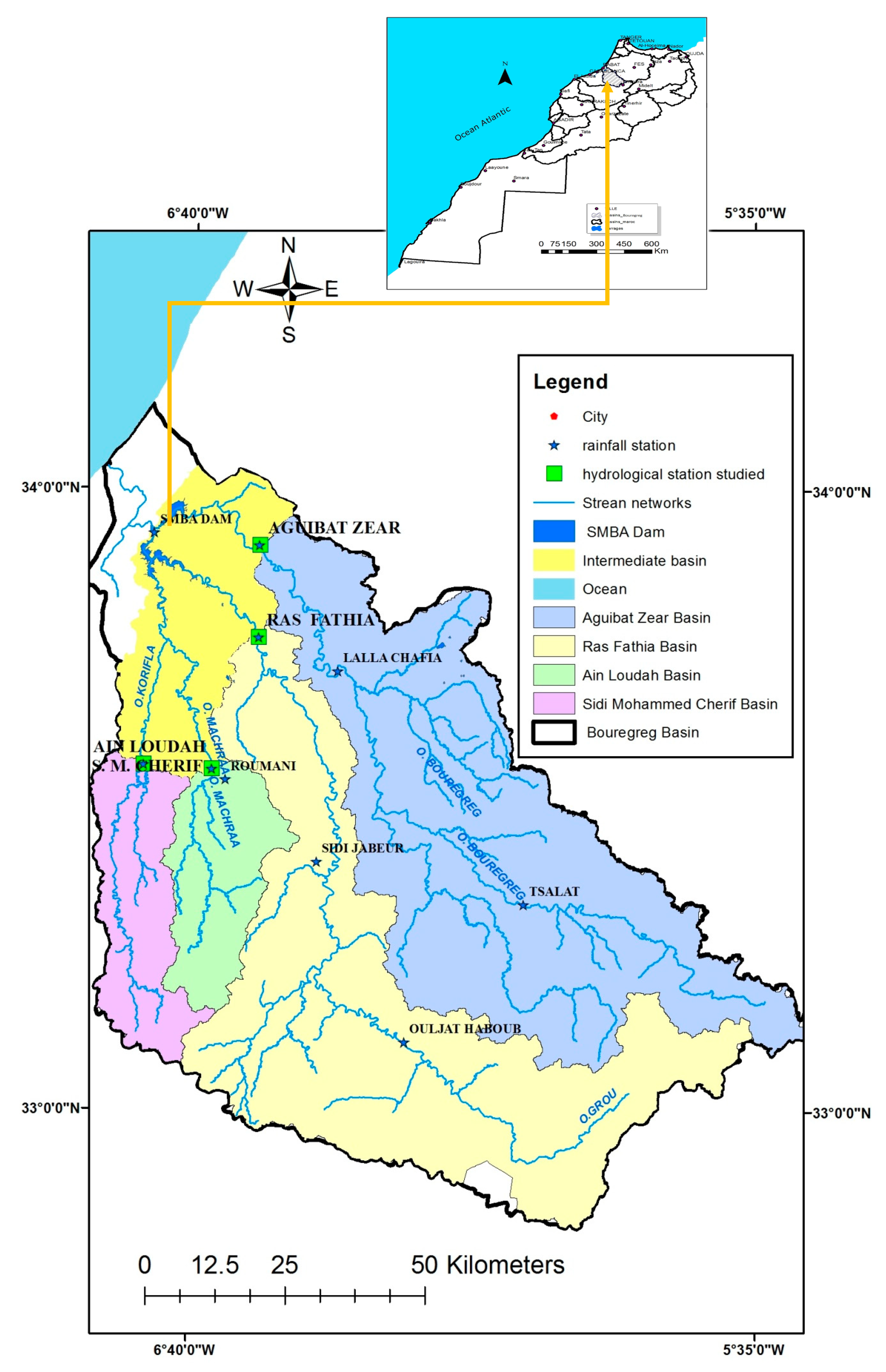
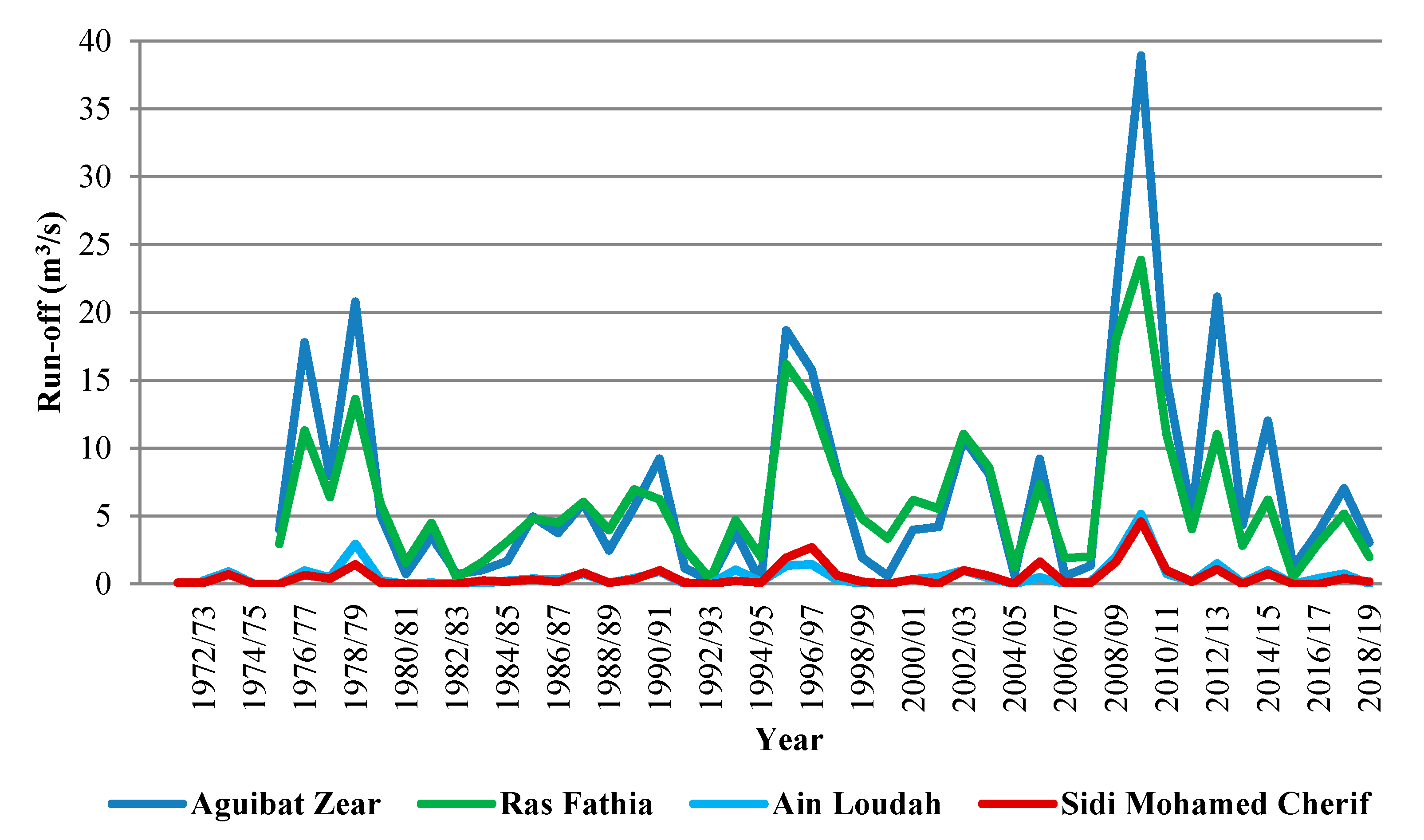
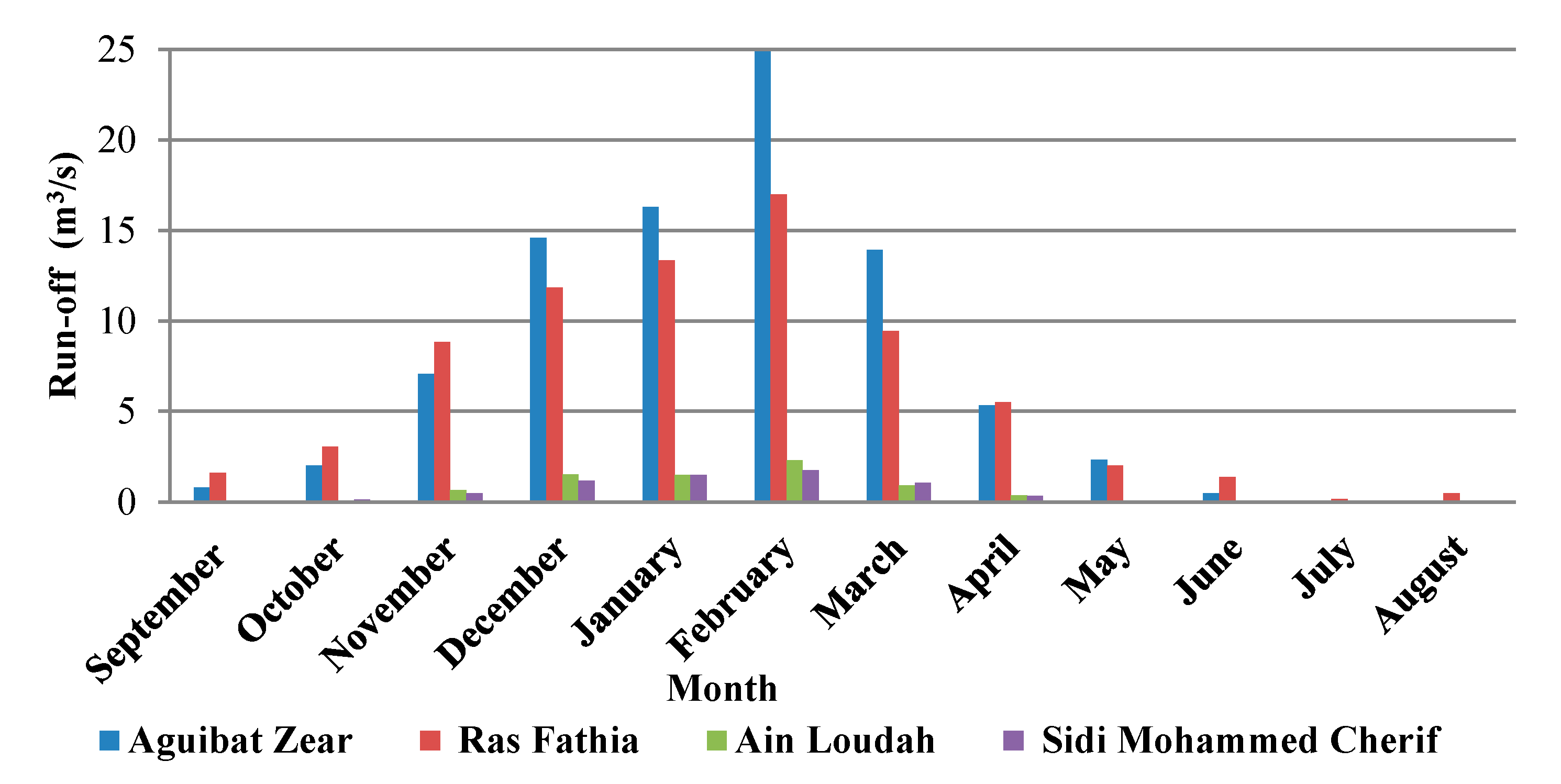
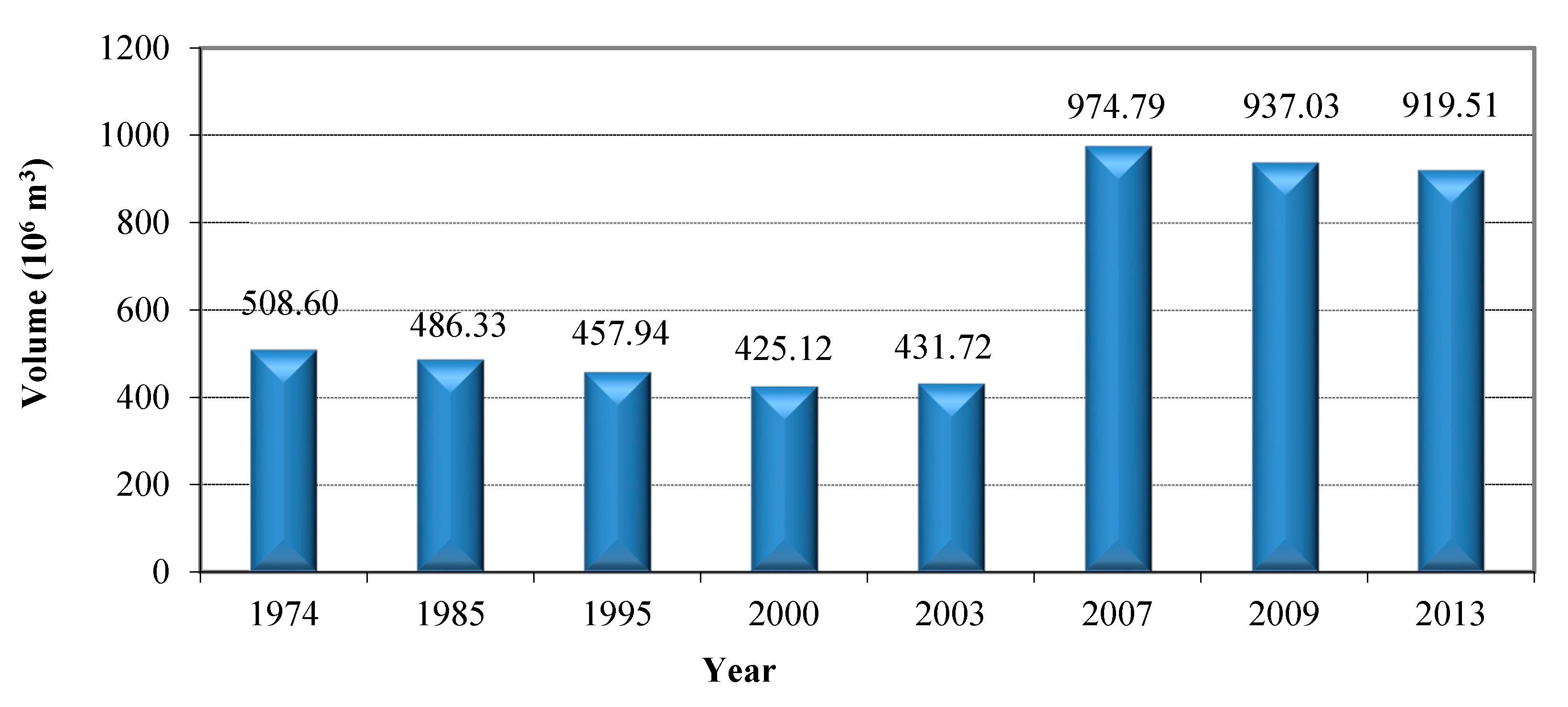
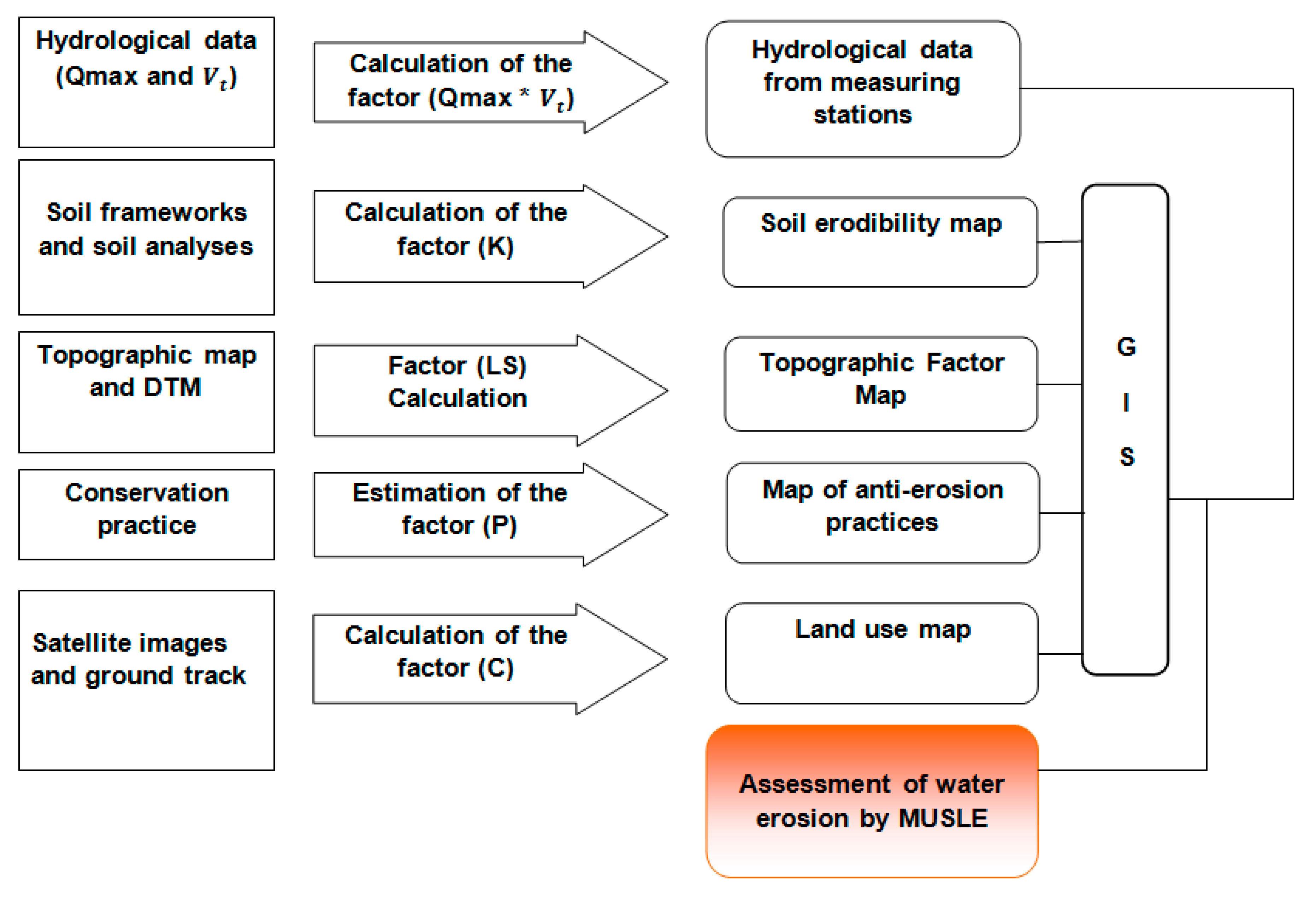
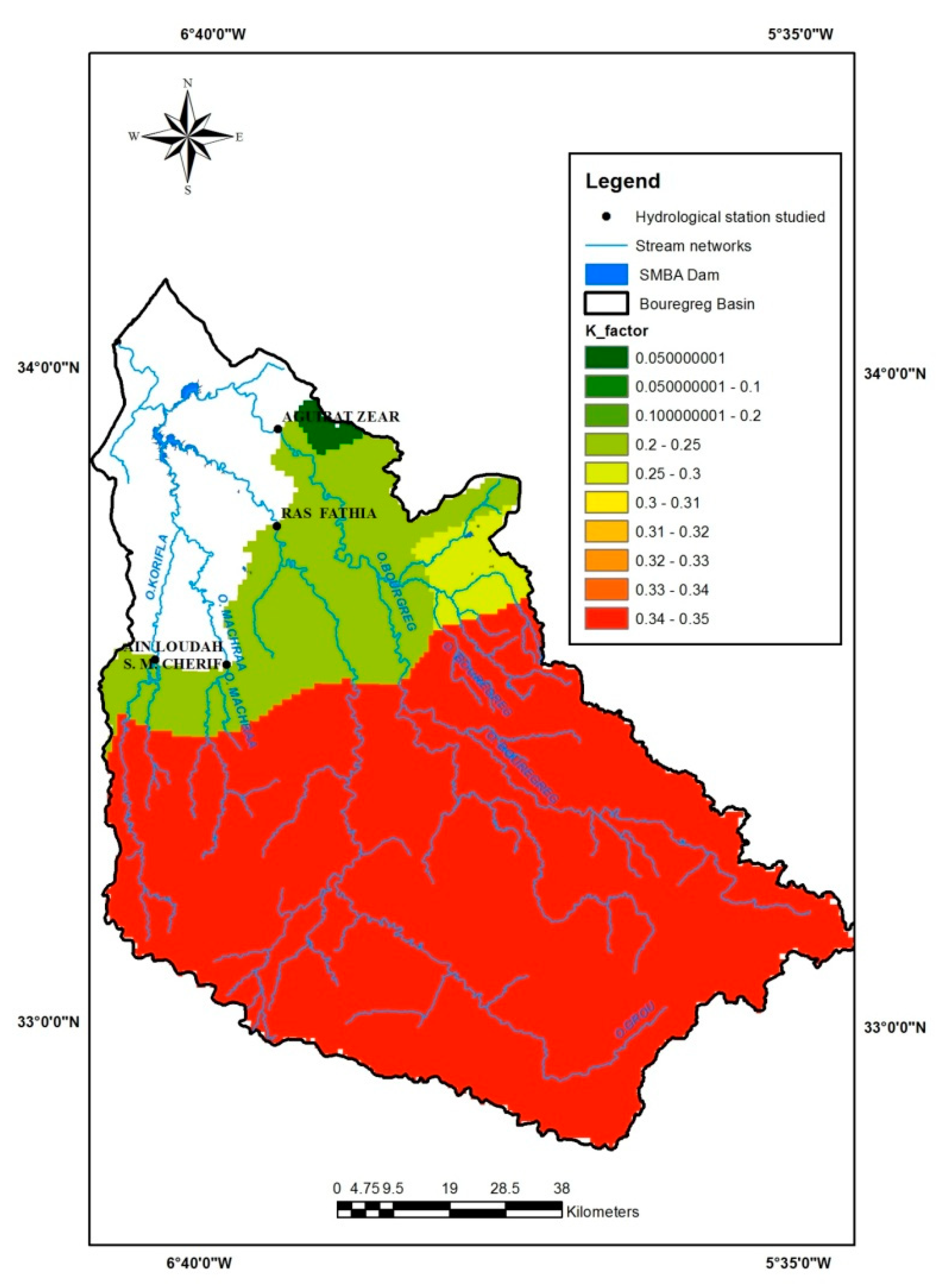
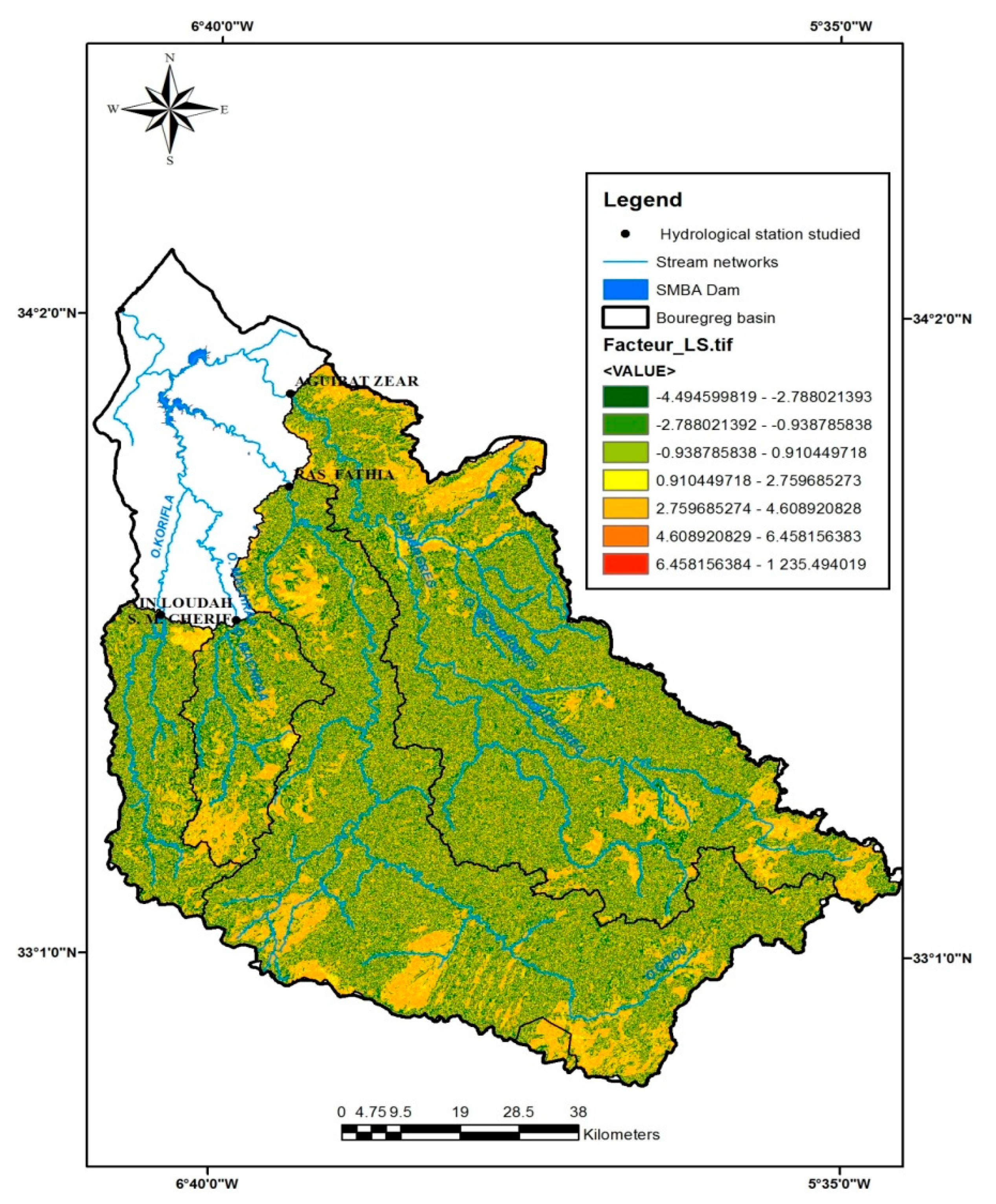
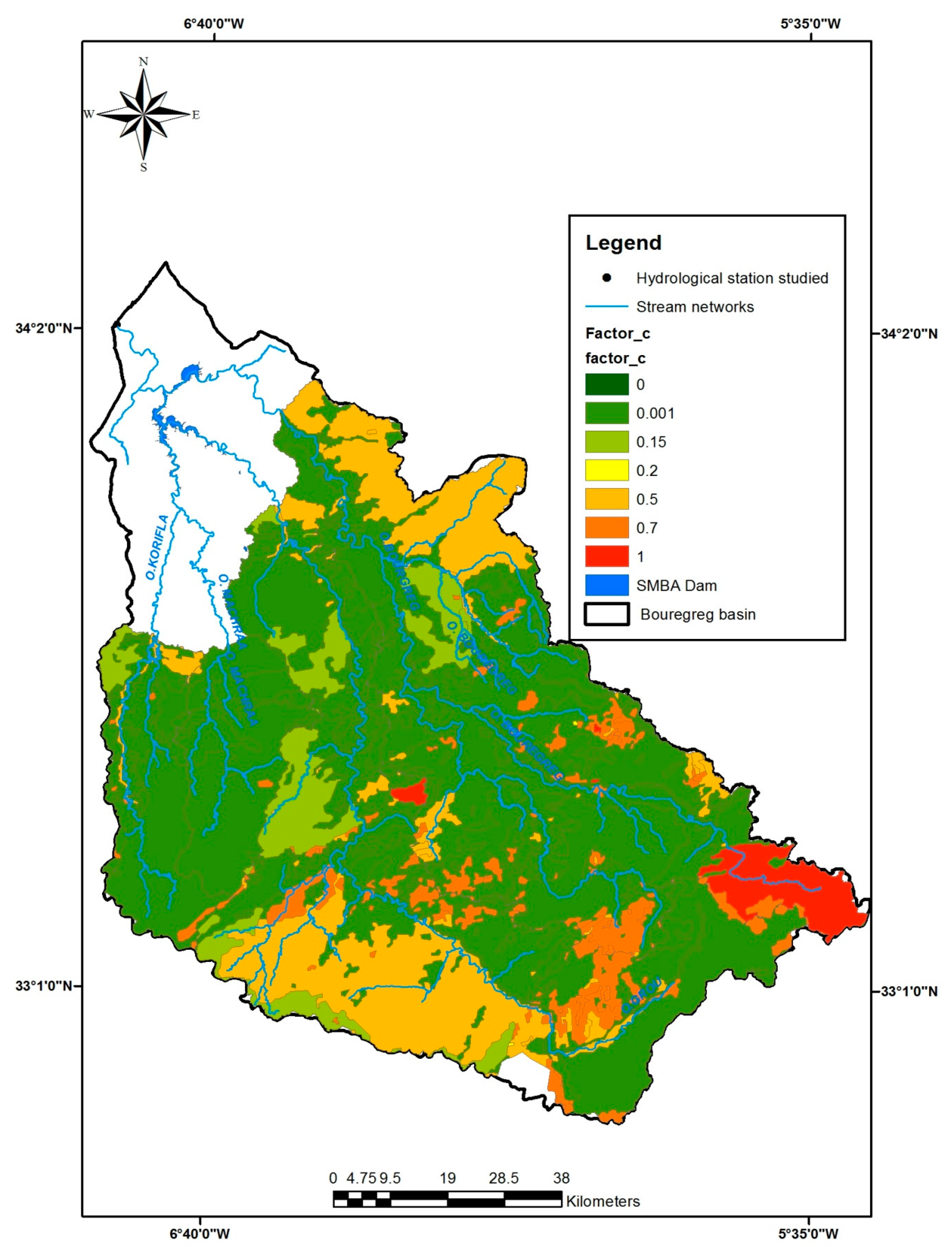
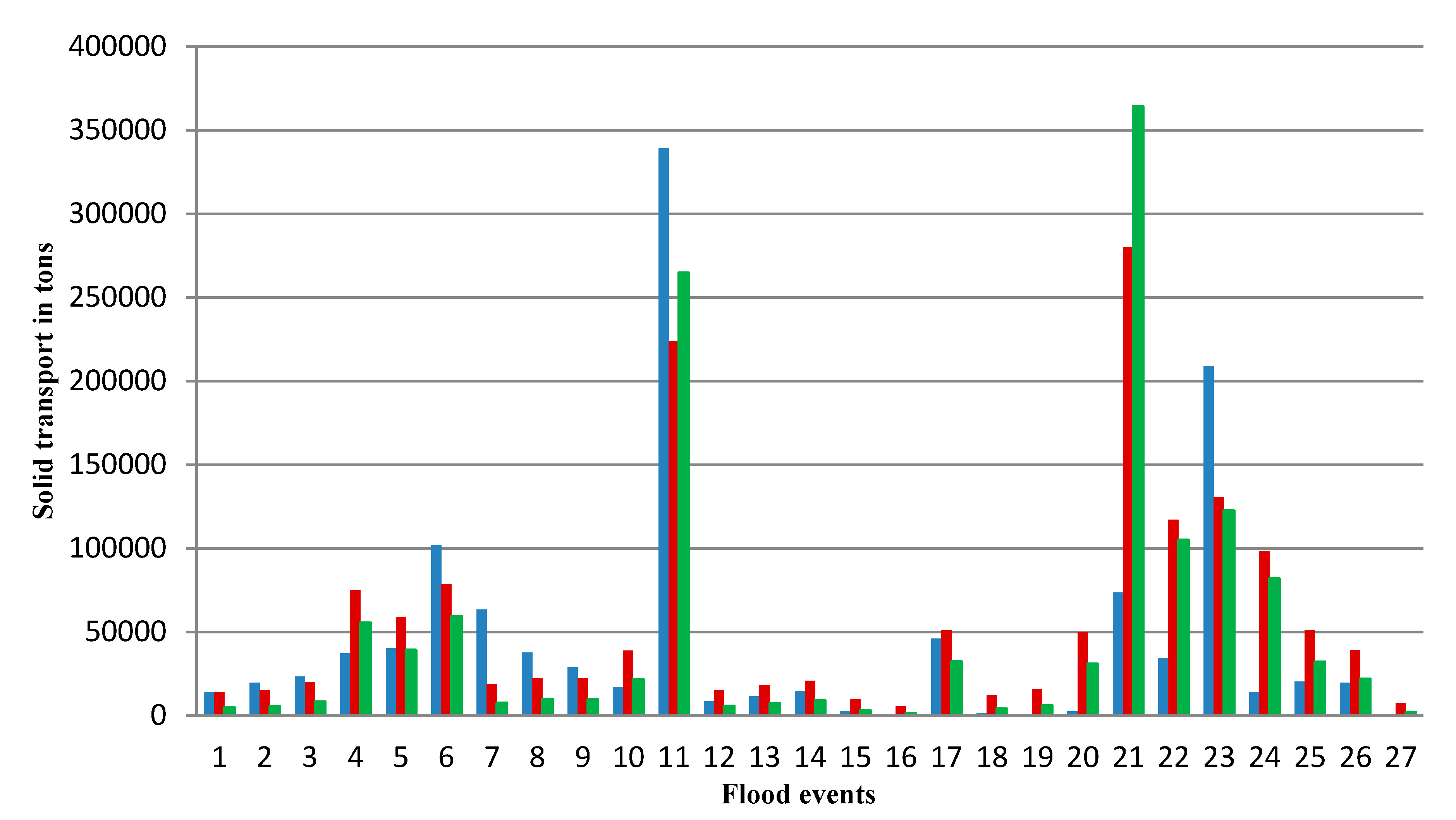
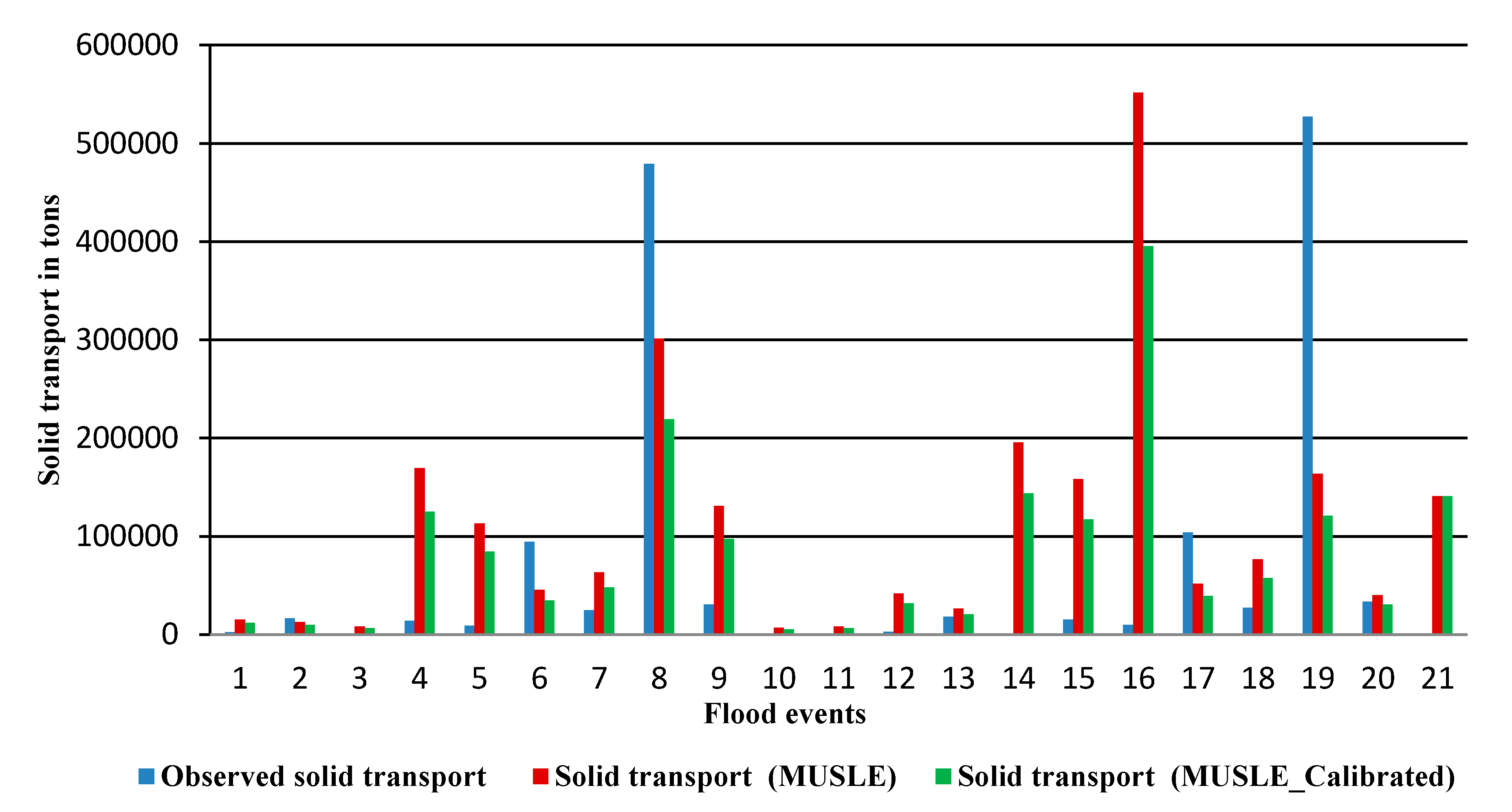
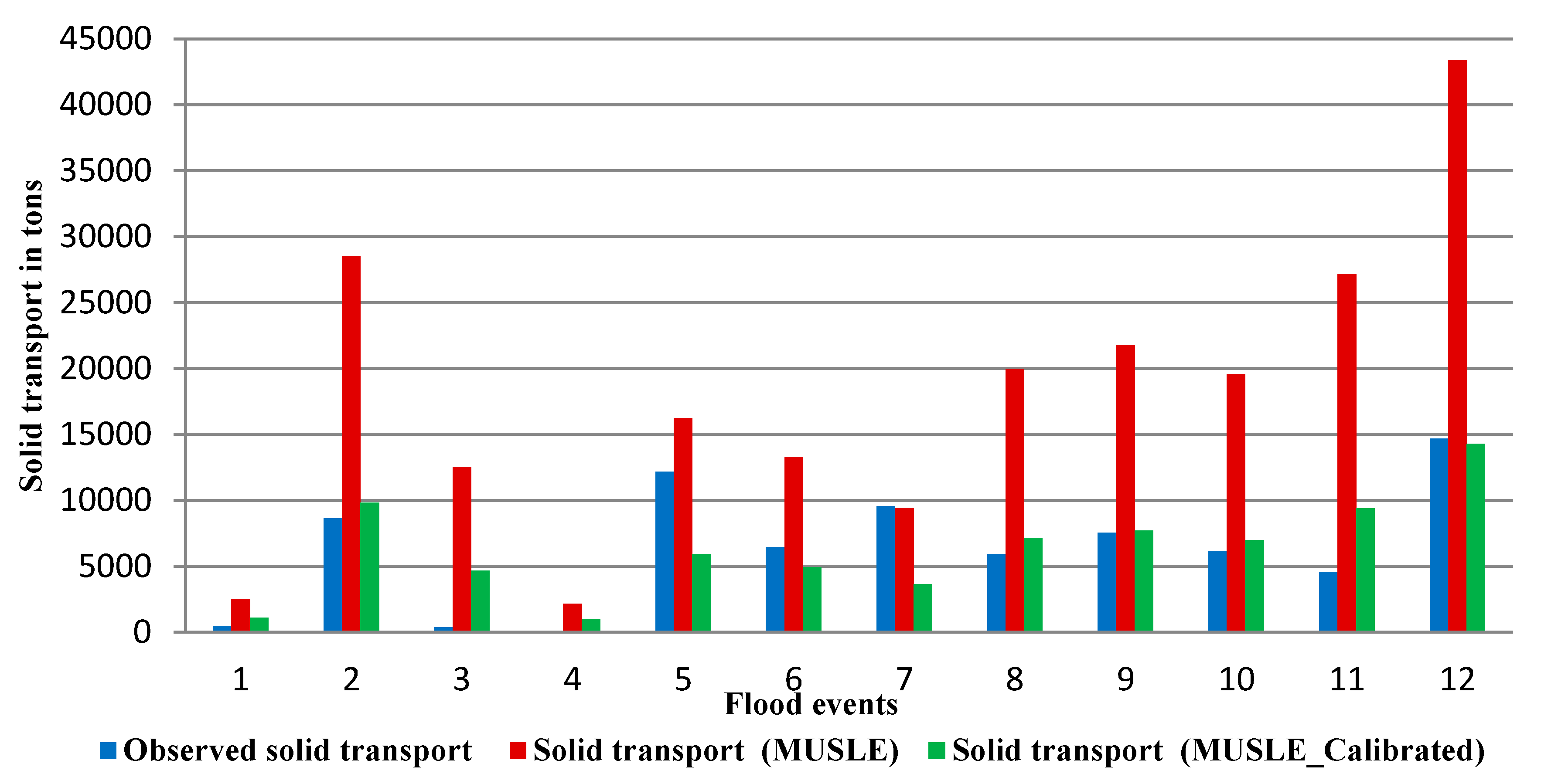

| Watershed Area (km²) | Initial Dam Capacity (106 m3) | Inter-Annual Water Resources (106 m3) | Opening Date | Number of Bathymetric Measurements | |
|---|---|---|---|---|---|
| SMBA at its construction | 9800 | 508.6 | 680 | 1974 | 5 |
| SMBA after raising its dike | 974.0 | 2007 | 3 |
| Hydrological Station | Name of River | Date of Commissioning | Averaging Period | N°IRE ABHBC Code | Watershed Area (km²) | Lambert Coordinates | ||
|---|---|---|---|---|---|---|---|---|
| X | Y | Z | ||||||
| Aguibat Zear | Bouregreg | 1975 | 1975/2018 | 3118/13 | 3681 | 394.500 | 368.150 | 90 |
| Ras Fathia | Grou | 1975 | 1975/2018 | 989/20 | 3485 | 394.250 | 351.800 | 100 |
| Ain Loudah | Korifla | 1971 | 1971/2018 | 2673/20 | 699 | 373.750 | 329.150 | 175 |
| Sidi Mohamed Cherif | Machraa | 1971 | 1971/2018 | 2674/21 | 656 | 385.850 | 328.200 | 270 |
| Hydrological Station | Hydrological Year | Maximum Discharge Recorded Per Year (m3/s) | Date of Flood Event | Volume (106 m3) | Number of Flood Events |
|---|---|---|---|---|---|
| Aguibat Zear | 2016/2017 | 263.4 | 24/02/2017 at 23h00 | 52 | 13 |
| 2017/2018 | 265.9 | 07/03/2018 at 14h00 | 77 | 14 | |
| Ras Fathia | 2016/2017 | 256.4 | 25/02/2017 at 07h30 | 33 | 11 |
| 2017/2018 | 423.8 | 07/03/2018 at 09h00 | 59 | 10 | |
| Ain Loudah | 2016/2017 | 24.5 | 13/10/2016 at 11h00 | 0.7 | 10 |
| 2017/2018 | 198.7 | 24/04/2018 at 23h00 | 7.6 | 17 | |
| Sidi Mohamed Cherif | 2016/2017 | 62.6 | 13/10/2016 at 07h00 | 1.8 | 6 |
| 2017/2018 | 48.0 | 11/12/2017 at 17h00 | 1.28 | 6 |
| Name of Hydrological Station | River | Watershed Area (km²) | 2016/2017 and 2016/2018 | |
|---|---|---|---|---|
| Number of CSS Samples | Number of Flood Events | |||
| AguibatZear | Bouregreg | 3681 | 727 | 27 |
| Ras Fathia | Grou | 3485 | 636 | 21 |
| Ain Loudah | Korifla | 699 | 233 | 27 |
| Sidi Mohamed Cherif | Machraa | 656 | 789 | 12 |
| Name of the Dam | Initial Dam Capacity (106 m3) | Total Siltation (106 m3) | Number of Years | Rate of Siltation (106 m3) | Dead-unit Volume at Dam Building (106m3) | Lost Volume (%) | Current Capacity (106 m3) |
|---|---|---|---|---|---|---|---|
| SMBA before raising | 508.60 | 76.88 | 29 | 2.65 | 100.00 | 15 | 431.72 |
| SMBA after raising | 974.79 | 55.28 | 6 | 9.49 | 6 | 919.51 |
| Rain Gauge Station | Basin | Cumulative Rainfall (mm) | Averaging Period | Mean Year (mm) | Deviation from the Mean (%) | ||
|---|---|---|---|---|---|---|---|
| 2016/2017 | 2017/2018 | 2016/2017 | 2017/2018 | ||||
| LallaChafia | Bouregreg | 409 | 569 | 1972/2019 | 486 | −16 | 17 |
| AguibatZear | Bouregreg | 482 | 578 | 1975/2019 | 429 | 12 | 35 |
| Sidi Jabeur | Grou | 260 | 432 | 1971/2019 | 317 | −18 | 36 |
| Tsalat | Bouregreg | 454 | 622 | 1977/2019 | 469 | −3 | 33 |
| Roumani | Machraa | 261 | 431 | 1933/2019 | 342 | −24 | 26 |
| Ras Fathia | Grou | 290 | 505 | 1975/2019 | 387 | −25 | 30 |
| S. M Cherif | Machraa | 290 | 495 | 1971/2019 | 367 | −21 | 35 |
| Barrage SMBA | Bouregreg | 518 | 479 | 1984/2019 | 469 | 10 | 2 |
| OuljatHaboub | Grou | 321 | 350 | 1972/2019 | 311 | 3 | 12 |
| Ain Loudah | Krofla | 258 | 498 | 1971/2019 | 347 | −26 | 43 |
| Total | 354 | 496 | 392 | −10 | 26 | ||
| Hydrological Station | River | Water Supply (Mm3) | Deviation from the Mean (%) | ||||
|---|---|---|---|---|---|---|---|
| 2016/2017 | 2017/2018 | Averaging Period | Annual Average (mm) | 2016/2017 | 2017/2018 | ||
| AguibatZear | Bouregreg | 122.2 | 221.5 | 1975/2019 | 227.6 | −46 | −3 |
| Ras Fathia | Grou | 95.0 | 162.8 | 1975/2019 | 194.2 | −51 | −16 |
| Ain Loudah | Korifla | 13.3 | 23.5 | 1971/2019 | 18.9 | −29 | +24 |
| Sidi Mohammed Cherif | Machraa | 3.7 | 12.9 | 1971/2019 | 16.7 | −77 | −23 |
| Name Watershed | Erodibility Factor Kaverage |
|---|---|
| Bouregreg | 0.352 |
| Grou | 0.350 |
| Ain Loudah | 0.348 |
| Sidi Mohamed Cherif | 0.348 |
| Mean Slope (%) | Mean Topographic Factor (Ls) | |
|---|---|---|
| Bouregreg à Lala Chafia | 16.6 | 0.48 |
| Grou à Ras Fathia | 14.6 | 0.49 |
| Korifla à Ain Loudah | 9.8 | 0.27 |
| Machraa à Sidi Mohamed Cherif | 12.2 | 0.58 |
| Watershed | Land Cover Factor (C) Caverage |
|---|---|
| Bouregreg | 0.26 |
| Grou | 0.45 |
| Korifla | 0.41 |
| Machraa | 0.33 |
| Mean Topographic Factor (LS) | Mean Erodibility Factor (K) | Mean Vegetation Cover Factor (C) | Mean Development Factor (P) | |
|---|---|---|---|---|
| Bouregreg | 0 48 | 0.32 | 0.26 | 1 |
| Grou | 0.49 | 0.32 | 0.45 | 1 |
| Korifla | 0.27 | 0.34 | 0.33 | 1 |
| Machraa | 0.58 | 0.31 | 0.41 | 1 |
| Name of Basin | Scaling Parameters after Calibration | Calibration Criteria | |||
|---|---|---|---|---|---|
| A | B | Bias | KGE | r | |
| Bouregreg | 11.799 | 0.548 | 0.00 | 0.48 | 0.58 |
| Grou | 11.799 | 0.535 | 0.00 | 0.11 | 0.26 |
| Korifla | 11.800 | 0.541 | 0.00 | 0.49 | 0.57 |
| Machraa | 11.799 | 0.502 | 0.00 | 0.65 | 0.70 |
| Name of Basin | Scaling Parameters after Calibration | Calibration Criteria | |||
|---|---|---|---|---|---|
| A | b | Bias | KGE | r | |
| Bouregreg | 0.039 | 0.807 | 0.024 | 0.601 | 0.603 |
| Grou | 11.799 | 0.546 | −0.236 | 0.149 | 0.272 |
| Korifla | 1.727 | 0.643 | −0.055 | 0.537 | 0.545 |
| Machraaf | 1.421 | 0.620 | −0.017 | 0.689 | 0.690 |
| Hydrologic Year | Observed Solid Transport (tons) | Solid Transport (MUSLE) (tons) | Difference Observation-MUSLE (%) | ||||
|---|---|---|---|---|---|---|---|
| Uncalibrated | Calibration PBAIS | Calibration KGE | Uncalibrated | Calibration PBAIS | Calibration KGE | ||
| 2016/2017 | 742 334 | 619 023 | 487 494 | 436 922 | −17 | −34 | −41 |
| 2017/2018 | 439 735 | 888 011 | 694 575 | 716 809 | +102 | +58 | +63 |
| Hydrologic Year | Observed Solid Transport (tons) | Solid Transport (MUSLE) (tons) | Difference Observation-MUSLE (%) | ||||
|---|---|---|---|---|---|---|---|
| Uncalibrated | Calibration PBAIS | Calibration KGE | Uncalibrated | Calibration PBAIS | Calibration KGE | ||
| 2016/2017 | 673 551 | 875 366 | 517 194 | 649 389 | +30 | −23 | −4 |
| 2017/2018 | 740 083 | 1 446 831 | 896 438 | 1 098 213 | +95 | +21 | +48 |
| Hydrologic Year | Observed Solid Transport (tons) | Solid Transport (MUSLE) (tons) | Difference Observation-MUSLE (%) | ||||
|---|---|---|---|---|---|---|---|
| Uncalibrated | Calibration PBAIS | Calibration KGE | Uncalibrated | Calibration PBAIS | Calibration KGE | ||
| 2016/2017 | 28,155 | 75,194 | 27,431 | 26,225 | +167 | −3 | −7 |
| 2017/2018 | 48,422 | 141,249 | 49,146 | 51,657 | +192 | +1 | +7 |
| Hydrologic Year | Observed Solid Transport (tons) | Solid Transport (MUSLE) (tons) | Difference Observation-MUSLE (%) | ||||
|---|---|---|---|---|---|---|---|
| Uncalibrated | Calibration PBAIS | Calibration KGE | Uncalibrated | Calibration PBAIS | Calibration KGE | ||
| 2016/2017 | 68,759 | 41,083 | 28,881 | 27,739 | −40 | −58 | −60 |
| 2017/2018 | 92,324 | 191,859 | 132,202 | 142,138 | +108 | +43 | +54 |
| Name of Basin | Scaling Parameters after Calibration | Nash–Sutcliffe Index (NSE) | ||
|---|---|---|---|---|
| a | B | MUSLE | MUSLE calibrated | |
| Bouregreg à Aguibat Zear | 11.799 | 0.548 | 0.38 | 0.46 |
| Grou à Ras Fathia | 11.799 | 0.535 | −0.07 | 0.02 |
| Korifla à Ain Loudah | 11.800 | 0.541 | −0.35 | 0.30 |
| Machraa à Sidi Mohammed Cherif | 11.799 | 0.502 | −9.8 | 0.47 |
| Name of Basin | Solid Transport 2016/2017 | Solid Transport 2017/2018 | ||||
|---|---|---|---|---|---|---|
| Observation | MUSLE | MUSLE calibrated | Observation | MUSLE | MUSLE calibrated | |
| Bouregreg | 742,334 | 619,023 | 487,494 | 439,735 | 888,011 | 694,575 |
| Grou | 673,551 | 875,366 | 517,194 | 740,083 | 1,446,831 | 896,438 |
| Korifla | 68,759 | 41,083 | 28,881 | 92,324 | 191,859 | 132,202 |
| Machraa | 28,155 | 75,194 | 27,431 | 48,422 | 141,249 | 49,146 |
| Total (tons) | 1,512,799 | 1,610,666 | 1,061,000 | 1,320,564 | 2,667,950 | 1,772,361 |
| Total (106 m3) | 1.01 | 1.07 | 0.71 | 0.88 | 1.78 | 1.18 |
| Hydrologic Year | Bathymetry (106 m3) | Difference MUSLE/ Observation | Difference MUSLE Calibrated/ Observation | Difference Observation/ Bathymetry | Difference MUSLE/ Bathymetry | Difference MUSLE Calibrated/Bathymetry |
|---|---|---|---|---|---|---|
| 2016/2017 | 9.25 | +5% | −30% | −89% | −89% | −93% |
| 2016/2018 | +102% | +34% | −91% | −81% | −88% |
© 2020 by the authors. Licensee MDPI, Basel, Switzerland. This article is an open access article distributed under the terms and conditions of the Creative Commons Attribution (CC BY) license (http://creativecommons.org/licenses/by/4.0/).
Share and Cite
Ezzaouini, M.A.; Mahé, G.; Kacimi, I.; Zerouali, A. Comparison of the MUSLE Model and Two Years of Solid Transport Measurement, in the Bouregreg Basin, and Impact on the Sedimentation in the Sidi Mohamed Ben Abdellah Reservoir, Morocco. Water 2020, 12, 1882. https://doi.org/10.3390/w12071882
Ezzaouini MA, Mahé G, Kacimi I, Zerouali A. Comparison of the MUSLE Model and Two Years of Solid Transport Measurement, in the Bouregreg Basin, and Impact on the Sedimentation in the Sidi Mohamed Ben Abdellah Reservoir, Morocco. Water. 2020; 12(7):1882. https://doi.org/10.3390/w12071882
Chicago/Turabian StyleEzzaouini, Mohamed Abdellah, Gil Mahé, Ilias Kacimi, and Abdelaziz Zerouali. 2020. "Comparison of the MUSLE Model and Two Years of Solid Transport Measurement, in the Bouregreg Basin, and Impact on the Sedimentation in the Sidi Mohamed Ben Abdellah Reservoir, Morocco" Water 12, no. 7: 1882. https://doi.org/10.3390/w12071882





